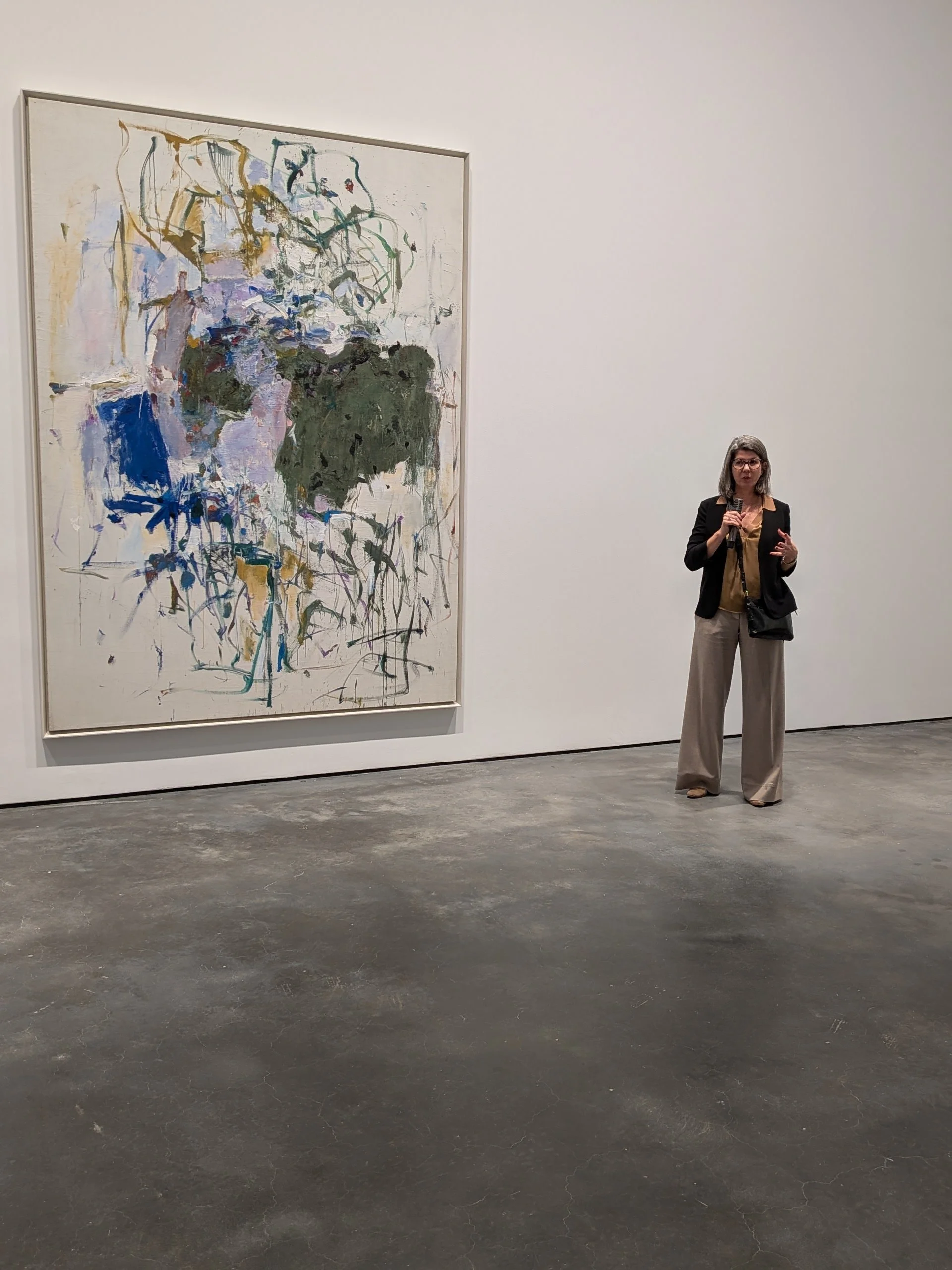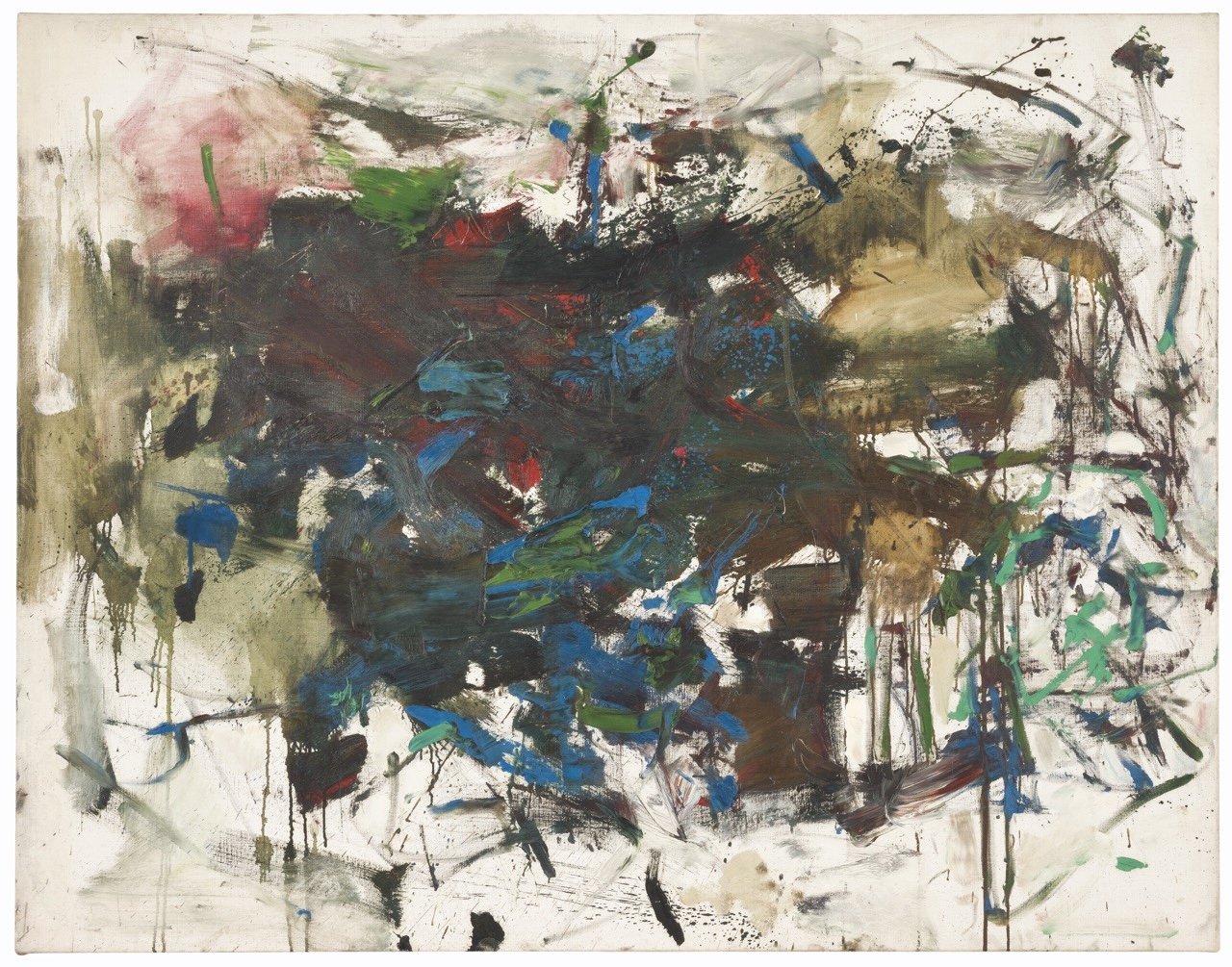Joan Mitchell's Dark Mediterranean: “That Awful Thing Called Nature”
Curator Sarah Roberts discusses an untitled Joan Mitchell piece from 1964. Photo by Lisa Freeman
"I would like to look out of a window or at photos or pictures or at that awful thing called nature. I'm trying for something more specific than movies of my everyday life: To define a feeling," Joan Mitchell was quoted as saying in the April, 1965, issue of ARTnews. That sardonic jab at nature—"that awful thing"—cuts to the heart of Mitchell's practice during the early 1960s, when summers spent sailing the Mediterranean with painter Jean Paul Riopelle generated some of her most visceral, probing canvases.
During those months she encountered countless examples of nature’s maritime wonders, the great blue-green seascapes, the cypress trees sprouting from limestone crags, the persistent surf lapping at lonely beaches, the ceaseless sunrises and sunsets. But she wasn’t there to paint these pretty scenes. She was there to wrestle feelings into visual form, to translate the psychological weight of rocky coasts and horizon lines into swirling masses of paint so dark they became known as the "black paintings."
David Zwirner's latest exhibition of Mitchell’s works, To define a feeling: Joan Mitchell, 1960–1965, isolates this brief but important period. Curated by Sarah Roberts, senior director of curatorial affairs at the Joan Mitchell Foundation, the exhibition demonstrates how Mitchell took what she encountered in the Mediterranean and turned it into something complex and enduring.
Curator Sarah Roberts discussing a piece from Mitchell's Paris period that preceded the so-called black period. Photo by Lisa Freeman
The show includes paintings from Mitchell’s time on the Mediterranean, along with context provided by some works painted earlier after she acquired a spacious studio in Paris. “Because the period is really not very well known and actually hasn't been shown very much, we decided to do a little bit of a bigger exhibition to show you how she got to the black paintings, what came before,” Roberts said during a press walkthrough of the show.
As Roberts noted in the exhibition text, Mitchell sought to capture "multiple layers of human experience—things seen, touched, felt, and remembered—in a single visual field."
Two untitled works on view from this period clearly demonstrate Mitchell's evolving strategy for defining feeling. A circa 1963 canvas presents a dense, swirling mass of blue, green, and brown that dominates the center like a storm on a weather map, surrounded by agitated fields of cream and white. This suggests nature disturbed by its own turbulence—not landscape but the psychological residue of looking at landscape. Drips and splatters suggest urgency, but the composition maintains its gravitational center.
Joan Mitchell, Untitled, 1963. ©Estate of Joan Mitchell
A second untitled work, this one from 1964, breaks up those concentrated masses into what the gallery describes as "constellations of loopy, squared forms and tangled brushwork." Here, blocks of deep green and purple-blue float more independently, with calligraphic gestures in olive, yellow, and violet creating a looser, more scattered energy.
“By the time we get to 63, 64, she's really turned her attention outside the studio and towards the natural world. So there is this close association from work with landscape throughout. But the first time she started titling paintings and really acknowledging the natural world and its influence on her was in these period paintings,” Roberts said.
“They started spending weeks and sometimes months at a time based on the southern coast of France, sailing to Greece, to Italy, to Corsica,” Roberts said of Mitchell and her lover/partner/competitor Riopelle. “You picture these limestone cliffs, the cypress trees and the sparse vegetation….So she has moved from these very internally focused dynamics of working with paint (in the studio) to this connection to the natural world,” she said.
Mitchell's dismissal of "that awful thing called nature" masked a deep engagement with the natural world—though it was always filtered through feeling rather than sight. As poet and art critic John Ashbery observed in his ARTnews profile, paintings like Girolata could "look very much like a fairly literal impression of the face of a cliff speckled with vegetation." Still, like her colleagues in the Abstract Expressionist movement, Mitchell was looking for something more psychologically complex than mere impressions of landscapes. "I'm trying to remember what I felt about a certain cypress tree and I feel if I remember it, it will heal me somehow or I will be healed," she wrote to Ashbery.
Gallerist David Zwirner was on hand as curator Sarah Roberts discussed Mitchell’s work with journalists. Photo by Lisa Freeman
Born in Chicago in 1925, Mitchell established herself within New York's Abstract Expressionist circle. But while Jackson Pollock was dripping and Willem de Kooning was slashing, Mitchell was building paintings that refused the either/or of abstraction versus representation. Her Mediterranean paintings ably make this point: they aren’t representations of seascapes and jagged rock formations; they are nature paintings that mock nature, feeling made visible through "that awful thing" transformed.
The 1960–1965 period marked a deliberate break from Mitchell's earlier, more saturated palette and landscape-inspired compositions. "Central masses of densely applied paint in somber tones began to emerge in her canvases in 1960. By 1962, she had narrowed the range of hues to the darkest greens, browns, and blues, colors so deep that this group of works has frequently been referred to as the 'black paintings,' though true black was rarely included," the gallery said.
Her use of these central masses flew in the face of the accepted rules of Abstract Expressionism. This was her intent: American art critic "Clement Greenberg said there never should be a central image, so I decided to make one," Mitchell told art historian Dorothy Seckler in a 1965 oral history. With these works, Mitchell challenged prevailing conventions of abstract painting, shifting her central forms slightly off-axis and playing with backgrounds and corners.
The Zwirner show includes significant loans: Mandres, circa 1962 (Private Collection, courtesy of McClain Gallery), an expansive diptych engaging varied forms of the sea; Untitled, 1963 (The Museum of Modern Art, New York), a characteristic triptych demonstrating Mitchell's growing engagement with multi-panel works; and small-scale paintings inspired by Paris Metro stations that debuted in her 1965 Stable Gallery exhibition in New York, including one from Hofstra University Museum of Art.
Several large-scale paintings from the Joan Mitchell Foundation's collection span these years, alongside rarely seen works on paper combining charcoal, crayon, and sometimes watercolor—extending Mitchell's formal and chromatic explorations into different media. Primary archival materials from the Foundation supplement the exhibition, and a fully illustrated catalogue with new scholarship by Roberts and others is forthcoming from David Zwirner Books.
A man considers Joan Mitchell's Untitled, 1964
In his essay, Ashbery noted that Mitchell called herself a "visual painter" who didn't talk much about her work "perhaps not out of reticence, but because the paintings are meaning and therefore do not have a residue of meaning which she can talk about." The paintings from 1960–1965 don't illustrate feelings about the Mediterranean—they are those feelings, defined through paint rather than language.
Mitchell's career spanned more than four decades until her death in 1992, producing not only the large-scale abstract canvases for which she's best known but also smaller paintings, drawings, and prints. This focused exhibition, though, captures Mitchell at her most daring and moody—a painter who understood that defining a feeling required transforming "that awful thing called nature" into something more specific, more psychologically honest, than any literal seascape could ever be.
To define a feeling: Joan Mitchell, 1960–1965, runs through December 13 at David Zwirner’s gallery at 537 West 20th Street in Chelsea.





